|
Mazda RX-8
Debut: 2003
Maker: Mazda
Predecessor: no |
|
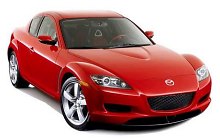 Introduction Introduction
This
year is the 40th anniversary of the world’s first production Wankel
rotary
engine car, NSU Spyder. Unlike what Dr. Wankel thought then, the rotary
revolution did not happen. Worse still is that since Mazda RX-7 died
last
August (2002), the world no longer has any rotary-engined cars on sale.
For many years, rotary engine was regarded as a dying breed of engines,
blame to its heavy fuel consumption and poor emission which failed to
comply
with the latest regulations. At one stage, Mazda seemed to give up the
development of its rotary engine and RX-7. However, in the 1999 Tokyo
Motor
Show, Mazda suddenly announced a new rotary concept car called RX EVOLV
- which eventually becomes the production RX-8 - with a breakthrough in
rotary technology. Calling RENESIS (stands for Rotary Engine Genesis),
the new rotary engine adopts several new ideas to reduce fuel
consumption
and clean up emission. It complies with the tough Euro IV emission
standard,
ensuring a bright future for the rotary engine. RX-8 can therefore be
sold
worldwide, from Japan, USA to Europe.
The
Chassis
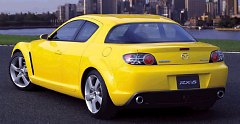 In
my opinion, RX-8 is perhaps the most interesting new car in 2003,
because
it is so different from other cars. It might not be
Pininfarina-beautiful,
but I do love its unique shape. Not only look like no other cars, it
doesn’t
have any resemblance to RX-7 too, with the exclusion of the wrap-around
rear glass. In
my opinion, RX-8 is perhaps the most interesting new car in 2003,
because
it is so different from other cars. It might not be
Pininfarina-beautiful,
but I do love its unique shape. Not only look like no other cars, it
doesn’t
have any resemblance to RX-7 too, with the exclusion of the wrap-around
rear glass.
Inside,
the RX-8 also gives you plenty of reasons to purchase it. Unlike Mazda
6, the dashboard and console is stylish and has a quality feel. The
sports
bucket seats look superb and feel just as good.
Now
you can see the biggest difference between RX-8 and RX-7 and why the
former
is not a direct successor to the latter - RX-8 is a genuine 4-seater
coupe
instead of a 2-seater or 2+2 sports car. It also has a pair of tiny
rear
doors which is rear-hinged (so-called "suicide doors"). With the rear
doors
and lack of B-pillar, people can get into the rear seats easily. At the
back, there is sufficient room for average-size adults, although a
6-footer
will find space confined if he sit behind another 6-footer.
 To
compensate for the lack of B-pillars, RX-8 uses a backbone-type
monocoque
chassis which has a strong transmission tunnel to reinforce the
chassis.
In fact, it is twice as stiff as RX-7 in torsional rigidity, believe or
not! To
compensate for the lack of B-pillars, RX-8 uses a backbone-type
monocoque
chassis which has a strong transmission tunnel to reinforce the
chassis.
In fact, it is twice as stiff as RX-7 in torsional rigidity, believe or
not!
Not
just that, the 4-seater also balances better than RX-7. By redesigning
the oil pan under the engine, the new Wankel engine sits 4cm lower than
RX-7’s to lower center of gravity. The whole unit is located 14cm
behind
front axle, no wonder front-to-rear weight distribution is a perfect
50:50.
At the rear, Mazda deleted the spare wheel and install the fuel tank
under
the rear seats so that now both the engine and the fuel tank are
located
within the wheelbase. In other words, it achieves a polar moment of
inertia
5% lower than that of the RX-7.
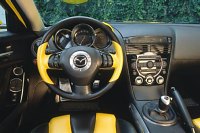 Low
center of gravity, low polar moment of inertia and perfect weight
distribution
are what all sports car engineers dream for, but not many cars can
achieve
them. For example, Nissan 350Z with its big V6 engine achieves only
53:47
and a much higher polar moment of inertia because a portion of its V6
hangs
over the front axle. Benefited by the weight and size advantage of
Wankel
engine, Mazda RX-8 can easily beat its opposition even though it is a
4-seater.
Chassis engineers will love this car. Low
center of gravity, low polar moment of inertia and perfect weight
distribution
are what all sports car engineers dream for, but not many cars can
achieve
them. For example, Nissan 350Z with its big V6 engine achieves only
53:47
and a much higher polar moment of inertia because a portion of its V6
hangs
over the front axle. Benefited by the weight and size advantage of
Wankel
engine, Mazda RX-8 can easily beat its opposition even though it is a
4-seater.
Chassis engineers will love this car.
The
rest of the chassis is also up to standard. Suspensions are
double-wishbones
up front and 5-link at the rear. Steering is by electric assistance to
save weight. Brakes are also pretty big (323mm front, 302mm rear).
RX-8
weighs only 1300kg, about the same as RX-7, or undercutting a BMW 330Ci
by 200kg. We must praise its attention to weight control.
The
RENESIS Engine
We
have mentioned that the new rotary engine made a breakthrough in fuel
efficiency
and emission level. How did it work out? in the past, rotary engines
had
their exhaust ports located at the face of the combustion chambers.
This
made packaging easier but there are 2 disadvantages: firstly, it
creates
overlapping between intake and exhaust phase, thus exhaust gas always
contaminate
fresh air and fuel mixture, reducing burning efficiency and worsening
emission.
Secondly, because the exhaust port is at the outer surface of the
combustion
chamber, any residual fuel failed to be burnt in combustion cycle will
be pushed towards the exhaust port by rotor tips. As a result, the
unburned
fuel will emit from the engine directly and adds to the
pollutants.
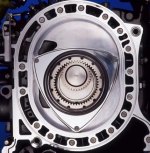 Unexpectedly,
Mazda solved these problems easily by relocating the intake and exhaust
ports to the side of the combustion chambers. As a result, overlapping
between intake and exhaust phase no longer exist. Now fresh air and
exhaust
gas are separated. Besides, any unburned fuel will not enter the
exhaust
ports easily because the ports are distanced from the outer surface of
combustion chambers. Instead, the residual fuel will be carried over to
the next combustion cycle and burn out completely. Unexpectedly,
Mazda solved these problems easily by relocating the intake and exhaust
ports to the side of the combustion chambers. As a result, overlapping
between intake and exhaust phase no longer exist. Now fresh air and
exhaust
gas are separated. Besides, any unburned fuel will not enter the
exhaust
ports easily because the ports are distanced from the outer surface of
combustion chambers. Instead, the residual fuel will be carried over to
the next combustion cycle and burn out completely.
Furthermore,
side intake and exhaust ports bring 2 more advantages. Firstly, the
outer
surface of combustion chamber is now smooth thus easier to lubricate.
This
reduce the wear on rotor tip sealing and eventually improve durability,
which was a headache of older rotary engines. Secondly, by moving the
ports
to the side, Mazda find space to enlarge them considerably. For
example,
the intake ports are 30% larger than that of the old 13B engine used by
RX-7. This of course improves breathing smoothness and lifts power
output.
Unfortunately,
the RENESIS used by RX-8 is normally aspirated only. It displaces the
same
as RX-7, that is, twin rotors with a total displacement of 1308 cc.
Because
a rotor chamber combusts once every revolution, compare with piston
engine’s
once every 2 revolutions, its effective displacement is actually 2616
cc
by the norm of piston engines. The RX-7 with twin-turbochargers
generated
280 hp in its final phase of development. Without any forced induction,
the RX-8 can still achieve 250 hp (240 hp for European version), very
good
for a 2.6-litre engine. Its power curve is peaky though - maximum power
occurs at 8500rpm. The turbine-like engine can spin to a genuine
9000rpm,
no joking.
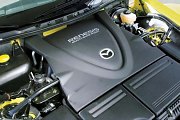 This
remind me another famously peaky engine - Honda S2000's F20C VTEC
engine.
Believe or not, despite of the vast differences in their design and
architecture,
these two engines are very close in their behaviour - the Honda reaches
max power at 8300rpm, both cut-out at 9000rpm, both are rated at 250hp
(JIS) and 240hp (DIN), and both have a weak torque curve. In the Honda
case, it is 160 lbft at 7500rpm. Mazda is slightly better, 159 lbft at
a more useable 5500rpm. But that’s still not anything to be proud of. This
remind me another famously peaky engine - Honda S2000's F20C VTEC
engine.
Believe or not, despite of the vast differences in their design and
architecture,
these two engines are very close in their behaviour - the Honda reaches
max power at 8300rpm, both cut-out at 9000rpm, both are rated at 250hp
(JIS) and 240hp (DIN), and both have a weak torque curve. In the Honda
case, it is 160 lbft at 7500rpm. Mazda is slightly better, 159 lbft at
a more useable 5500rpm. But that’s still not anything to be proud of.
The
250hp / 240hp RENESIS engine is equipped with a 3-stage variable intake
manifold. Mazda also offers a cheaper version RX-8 (around 10%
cheaper),
whose engine has just a fixed intake manifold which is tuned for
low-down
torque rather than high-end power. The result is slightly higher
maximum
torque and is reached at slightly lower rev, but the engine cuts out at
just 7500rpm and eventually deliver less power - 210hp at 7200rpm for
Japanese
version or 192hp for Europe version. The cheaper RX-8 also runs a
cheaper
gearbox - 5-speed manual instead of the high power version’s 6-speed
manual.
Seems that it is not cheap enough to justify the loss in performance.
On
the Road
As
before, the rotary engine is incredibly smooth. Its power is produced
linearly
across the sky-high rev range. Perhaps too linear, you need at least
4000rpm
to get sufficient performance. Due to the lack of torque, RX-8 doesn’t
feel as fire-breathing as other 250-horsepower cars, say, Audi TT V6.
Luckily,
its 6-speed gearbox is low geared and has close ratios to keep the
engine
boiling, and the shift is super-slick to encourage frequent changes,
which
is a must in order to extract the performance it deserves. Mazda claims
a top speed of 150mph and 0-60mph taking 6 seconds flat. Considering
the
40kg lighter Honda S2000 does that in 5.6 seconds, Mazda’s figure is
totally
believable.
 Around
town, the Wankel engine is pretty tractable. On motorway, 60mph in 6th
gear, it runs at a quiet 3000rpm, so cruising refinement is good. Around
town, the Wankel engine is pretty tractable. On motorway, 60mph in 6th
gear, it runs at a quiet 3000rpm, so cruising refinement is good.
Well,
this normally-aspirated version of Wankel engine may not match a proper
big capacity V6, but its packaging advantage is shown in handling. In
the
world of 4-seater coupe, no one else can match it in chassis balance -
not even BMW 3-series Coupe. This car is so composed, so smooth and so
agile in corners. No matter how hard you abuse it, it remains safe and
neutral. There is just not enough torque to induce dramatic oversteer
or
slide at the rear wheels. Therefore the high-threshold traction control
is rarely used.
The
steering is another delight. Turn-in is instantaneous and precise,
because
there is so little weight at the nose. The steering also transfers good
road feel to the driver’s hands, despite of its electrical
assistance.
Suspension
is well sorted, delivering a firm but well-damped ride in the same way
as BMW M3. As a result, RX-8 remains stable in cornering.
Verdict
Priced
at US$27,000 in the USA or £22,000 in the UK, the RX-8 is around
10% cheaper than a comparable equipped Nissan 350Z, 15-20% cheaper than
Audi TT 225hp, 25% below Audi TT V6 and undercut BMW 330Ci by
30%.
Unquestionably, it is a bargain. No wonder Mazda sets an ambitious
target
of selling 30,000 cars a year.
Comparing
RX-8 with others is not easy, because it is so unique in all area. It
is
a full 4-seater coupe, it has sports car performance and handling while
it is priced at the same level as super hot hatches. If we compare it
with
Alfa 147GTA or Golf R32, the Mazda will definitely run away with its
superior
handling and sophisticated image. If we compare it with BMW 330Ci, it
will
also beat the German car by handling and impress people by its unusual
character and bargain price. Nissan 350Z is faster, but it offers 2
seats
only thus is not a direct competitor to RX-8. Maybe the next generation
RX-7, if Mazda greenlight it, can rival it. Both Audi TT 225 and V6 are
actually 2+2. The 225 is outpaced, outhandled and undercut in price by
the Mazda. It’s also an old car, so you can forget it. The TT V6 has a
remarkable engine and transmission combo, but it is also a lazy
driver’s
car. In contrast, Mazda RX-8 is the real driver’s car. Its precision
and
feel inspires you to drive faster and faster, and eventually reward you
with higher level of satisfaction. A new class leader has been born.
|
| The
above report was last updated on 28 Feb
2003. All Rights Reserved. |
RX-8 2008 facelift
|
 Firstly,
AutoZine wish you a happy 2009. During the long holiday I am clearing
the debt remained last year. One of them is Mazda RX-8, which received
a facelift earlier in 2008. Firstly,
AutoZine wish you a happy 2009. During the long holiday I am clearing
the debt remained last year. One of them is Mazda RX-8, which received
a facelift earlier in 2008.
RX-8 had been around for 5 years without any significant revisions.
This was the first time it got a facelift and mechanical upgrade. The
exterior of the car was refreshed with new diamond shape grille,
sportier-looking brake intakes and fog lamps and a more aggressive air
dam. It looks far sharper than the old car, especially if you choose
the Type RS model (or R3 for overseas markets) which adds rear spoiler,
extended skirts and a set of stylish 19-inch forged alloy wheels. This
model also include 225/40 low-profile tires, Bilstein dampers, Recaro
leather bucket seats and an upgraded Hi-Fi. Meanwhile, all RX-8 got a
stronger front suspension tower bar to increase chassis rigidity by 5
percent.
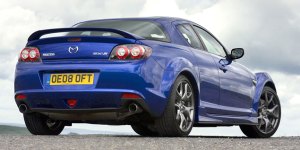 On
the road, these modifications result in sharper handling. Body control,
cornering stability and turn-in response are improved, making the RX-8
even more exciting to drive than the past. You can more lean on its
perfect chassis balance and delicious gearchange to attack corners.
What a pity the aging Wankel engine was not improved apart from using a
larger sump and new oil pump. Its lack of torque and heavy fuel
consumption remain its biggest weaknesses. During the past 5 years, the
RX-8 gained about 50 kg while its power rating dropped by 10-15 hp. Now
it needs around 6 and a half seconds to accelerate from rest to 60 mph,
no better than many hot hatches. On
the road, these modifications result in sharper handling. Body control,
cornering stability and turn-in response are improved, making the RX-8
even more exciting to drive than the past. You can more lean on its
perfect chassis balance and delicious gearchange to attack corners.
What a pity the aging Wankel engine was not improved apart from using a
larger sump and new oil pump. Its lack of torque and heavy fuel
consumption remain its biggest weaknesses. During the past 5 years, the
RX-8 gained about 50 kg while its power rating dropped by 10-15 hp. Now
it needs around 6 and a half seconds to accelerate from rest to 60 mph,
no better than many hot hatches.
To the fans of RX-8, top of the 2009 wish list must be a stronger and
more efficient Wankel engine. |
| The
above report was last updated on 1 Jan 2009. All
Rights Reserved. |
|
|